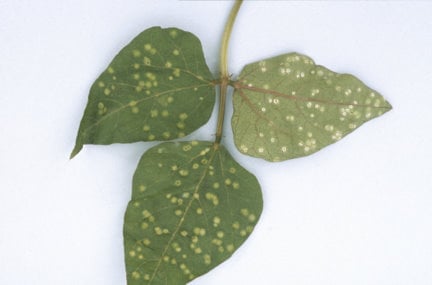
Quick facts
Common name - Runner and French bean rust
Scientific name - Uromyces appendiculatus
Plants affected - Phaseolus (dwarf, French, runner beans etc.)
Main symptoms - Brown, black or white spore pustules on leaves, stems or pods.
Caused by - Fungus
Timing - Summer
What is bean rust?
Bean rust is a fungal disease of the foliage, spread by airborne spores. Infection is favoured by wet weather conditions.
Symptoms
You may see the following symptoms:
- Initially, pale, raised spots appear on the upper leaf surface, corresponding to small white pustules on the lower surface. As summer progresses, tiny brown and then black pustules form on the lower leaf surface, often in great numbers. The black pustules also form on the upper surface. Pods may also be affected
- Heavily infected leaves turn brown and die, and severely affected plants may be stunted. It can also lead to shrivelling and shedding of leaves

Control
High levels of bean rust tend to develop quite late in the season (after mid-summer), and often have little effect on yield. However, prolonged spells of wet or humid, warm weather throughout the summer will increase the risk of infection.
Non-chemical control
- Thin out dense growth on bean crops to help reduce and thus the risk of infection
- Picking off affected leaves as soon as symptoms are seen should check the development of the disease. Symptoms tend to develop on older leaves first
- Dispose of any severely affected plants as these will produce huge numbers of spores
- Clear up and dispose of all debris (including fallen leaves) at the end of cropping
- Do not save seed from rust-affected crops
Chemical control
- There are no fungicides available to home gardeners for the control of bean rusts
Biology
Rust on Phaseolus beans is caused by the fungus Uromyces appendiculatus. It is unrelated to broad bean rust, which is caused by the fungus Uromyces viciae-fabae and infects Vicia beans.
The rust fungi are described as biotrophs; that is, they grow within the living tissues of the plant and extract from the cells. Although they do not kill tissues rapidly, heavy attacks by rusts can cause tissues to collapse and die prematurely and this is the case with the bean rusts. Some rusts require two different plant hosts in order to complete their life cycle but both of the bean rusts spend their entire life on the bean host.
The different coloured pustules seen on the plants as the summer progresses are the result of the rust fungi producing different types of spore. The brown pustules contain summer spores that can spread the disease very rapidly under suitable wet weather conditions, whilst the black pustules contain overwintering spores. These can survive on leaf debris to affect the following season’s crop.




